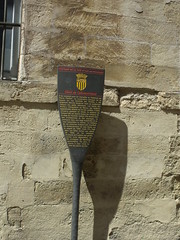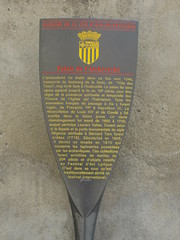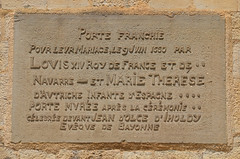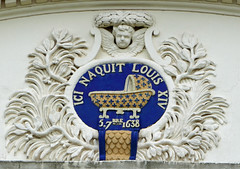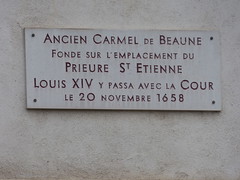King Louis XIV of France


King Louis XIV of France
(1638-1715)
King of France (1643-1715) and King of Navarre (1643-1715)
Family tree
Commemorated on 6 plaques
Hôtel de Châteaurenard Il fut construit pour un Conseiller au Parlement par Pierre Pavillion. La modénature baroque de sa façade sur rue dessinée par Pavillion a été largement détruite lorsqu'on voulu en moderniser l'aspect aux goûts classiques. Les traces des frontons triangulaires au dessus des fenêtres apparaissent encore sur le mur austère. L'hôtel conserve pourtant un trésor, la peinture en trompe-l'œil qui courve toutes les surfaces de la cage de l'escalier central. Elle montre dans des architectures et das paysages, un perroquet dans une cage suspendue et un valet accueillant le visiteur. Le réalisme de cet immense trompe-l'œil stupéfiait les contemporains de Jean Daret, qui le peignit en 1656. Louis XIV, logé dans cet hôtel durant son séjour de 1660, en fut tellement enchanté qu'il prévint ses gardes contre toute dégradation, en les menaçant de sanctions particulières. De plus, il donna à Jean Daret le titre de peintre du Roi.
English translation: Hotel de Châteaurenard It was built for a Councillor in Parliament by Pierre Pavillion. The Baroque modesty of its street façade designed by Pavillion has been largely destroyed in order to modernise its appearance to classic tastes. Traces of triangular pediments above windows still appear on the austere wall. However, the hotel retains a treasure, the trompe-l'oeil painting that travels all the surfaces of the cage of the central staircase. It shows in architectures and landscapes, a parrot in a hanging cage and a valet welcoming the visitor. The realism of this immense trompe-l'oeil amazed the contemporaries of Jean Daret, who painted it in 1656. Louis XIV, housed in this hotel during his 1660 stay, was so delighted that he warned his guards against any degradation, threatening them with special sanctions. He also gave Jean Daret the title of King's painter. [AWS Translate]
Rue Gaston de Saporta, Aix-en-Provence, France where they was
Palais de l'Archevêché L'archevêché fut établi dans ce lieu vers 1340, transporté du faubourg de la Seds, dit "Ville des Tours", trop isolé face à l'insécurite. Le Palais fut sans cesse agrandi jusqu'à la fin du 18e siècle, pour être digne de la puissance spirituelle et temporelle des Princes de l'église qui l'habitaient. Tous les souverains français de passage à Aix y furent logés, de François 1er à Napoléon III. La réconciliation de Louis XIV et de Condé y fut scellée dans le Salon jaune. Un vaste réaménagement fut mené de 1650 à 1730, auquel participa Laurent Vallon. Durant celluici la façade et la porte monumentale de style Régence attribuée à Bernard Toro furent créées (1715). Sécularisé en 1905, il devint un musée en 1910 qui conserve les tapisseries possédées par les archevêques. Ces collections furent enriches de textiles du 20e siècle et d'objets relatifs au Festival d'Art Lyrique. C'est dans sa cour qu'est traditionnellement abrité ce festival international.
English translation: Palace of the Archbishop The archbishop was established in this place around 1340, transported from the suburb of the Seds, called “City of Tours”, too isolated in the face of the insecurity. The Palace was constantly enlarged until the end of the 18th century, to be worthy of the spiritual and temporal power of the Princes of the Church who inhabited it. All the French rulers passing through Aix were housed there, from Francis 1st to Napoleon III. The reconciliation of Louis XIV and Condé was sealed in the Yellow Salon. A major redevelopment was carried out from 1650 to 1730, in which Laurent Vallon participated. During cellici the façade and the monumental Regency-style door attributed to Bernard Toro were created (1715). Secularized in 1905, it became a museum in 1910 that preserves the tapestries owned by the archbishops. These collections were enriched with 20th century textiles and objects related to the Lyric Art Festival. This international festival is traditionally housed in its courtyard. [AWS Translate]
Musée des Tapisseries - Palais de l'Archevêché - Place des Martyrs de la Resistance, Aix-en-Provence, France where they reconsolidated
Porte franchie, pour leur Mariage, le 9 Juin 1660 par Louis XIV, Roy de France et de Navarre - et Marie Therese d'Autriche, Infante d'Espagne. Porte Murée après la Cérémonie, célebrée devant Jean d'Olce d'Iholdy, Evêque de Bayonne.
English translation: Door crossed, for their wedding, on 9 June 1660 of Louis XIV, King of France and Navarre - and Marie Therese of Austria, Infante of Spain. Walled Door after the Ceremony, celebrated before Jean d'Olce d'Iholdy, Bishop of Bayonne.
rue Gambetta, Saint-Jean-de-Luz, France where they was
Ici naquit Louis XIV, 5.7bre 1638.
English translation: Louis XIV was born here 5 September 1638
19-21 Rue Thiers, Saint-Germain-en-Laye, France where they was born (1638)
Ancien Carmel de Beaune Fonde sur l'emplacement du Prieure St Etienne Louis XIV y passa avec la Cour le 20 Novembre 1658
English translation: Former Carmelite of Beaune Founded on the site of Prieure St Etienne Louis XIV went with the Court 20 November 1658
Place Félix Ziem, Beaune, France where they passed through (1658)
Le Château Vieux Construit Sur Lemplacement Du Castellum Romain Par Bertrand Vicomte De Bayonne A Ete Habite Par Don Alfonso Le Batailleur Roe De Navarre (1130) Le Prince Noir + Duguesclin Don Pedro Le Cruel Roi De Castille (1367) Louis XI (1463) Francois Ier (1526) Charles IX (1565) Louis XIV (1660) Marie Anne De Neubourg Reine D'espagne (1706) Let Le General Palafox Defenseur De Sar Agosse (1809)
English translation: The Old Castle Built on the site of the Roman Castellum by Bertrand Vicomte de Bayonne Has Been Habited By Don Alfonso The Fighter Roe Of Navarre (1130) The Black Prince + Duguesclin Don Pedro The Cruel King Of Castile (1367) Louis XI (1463) Francis I (1526) Charles IX (1565) Louis XIV (1660) Marie Anne De Neubourg Queen of Spain (1706) Let General Palafox Defender Of Sar Agosse (1809) [AWS Translate]
Château Vieux - Rue des Gouverneurs, Bayonne, France where they lived (1659)

